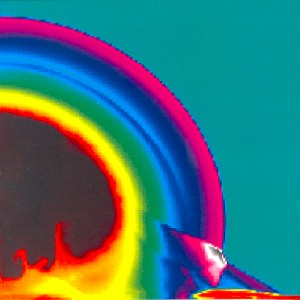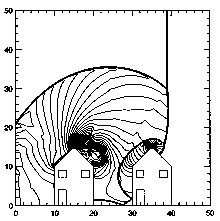Numerical simulation
DM&A perform hydrodynamic calculations independent of
experimentally measured data, including complete numerical simulations of explosions in
three dimensions involving complex interactions with rigid structures. Examples of
specific numerical simulations are illustrated below.

A simulated nuclear explosion over a flat reflecting
surface, made by placing a heated layer over the reflecting surface to model the effects
of thermal radiation. The main effect of the surface heating is a precursor shock, seen
here as a ramp-like structure running ahead of the expanding wave (lower right hand
corner). The coloured regions represent different air densities.

A blast wave interacting with two structures. The heavy
black lines are shock fronts and the lighter lines are contours of equal air density. From
simulations like this it is learned that blast waves are often enhanced in unexpected ways
as a result of interaction. A numerical simulation is a relatively inexpensive way to
prepare for accidents, at an explosive storage site for example.
 DM&A simulate explosions inside structures as well as outside,
including small explosions like those often encountered in terrorist situations. Numerical
simulation is also used to calculate the generic 'environmental enhancement' or 'E'
factors used by the EBlast expert system.
DM&A simulate explosions inside structures as well as outside,
including small explosions like those often encountered in terrorist situations. Numerical
simulation is also used to calculate the generic 'environmental enhancement' or 'E'
factors used by the EBlast expert system.

